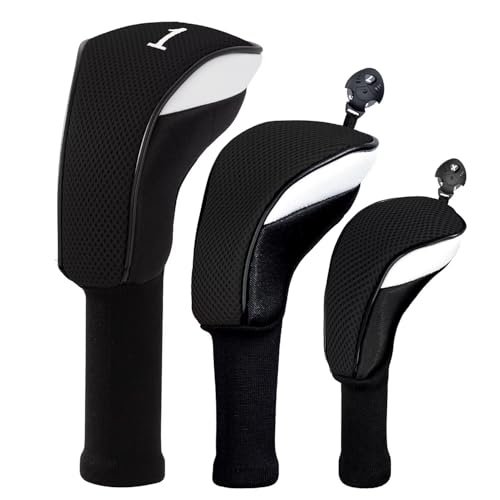Ever wondered why your shots at the driving range don’t quite match up to those on the course? It might not be your swing—it could be the golf balls. That’s right, not all golf balls are created equal, and some are specifically designed for limited flight.

You’ve probably noticed those range balls don’t soar as far as the ones you tee up on Sunday mornings. There’s a reason for that, and it’s not just to keep them from flying out of the range. Dive into the world of top golf balls and discover what makes them different from the ones in your bag.
What are limited flight golf balls?
Have you ever wondered why some balls just don’t fly as far, even with your best swing at the driving range? Limited flight golf balls are designed just for that—to travel a shorter distance. These golf balls are commonly used at driving ranges, especially those with restricted space. The science behind these marvels of golf technology lies in their internal construction which differs significantly from regular golf balls.
Unlike the high-performance balls you’d use on the course that are built for distance and accuracy, limited flight balls are typically constructed with a harder compression core and a modified dimple pattern. What does that mean for you? When you hit a limited flight ball, the energy from your swing isn’t transferred as efficiently as with a standard ball, resulting in less flight.
Another distinctive feature is the weight of these golf balls. They’re often slightly lighter or heavier than the standard balls you’re used to, an aspect that further limits their range. It’s like they have an invisible parachute holding them back.
Now don’t let their performance at the range fool you. Practicing with these balls still sharpens your swing mechanics and timing. It’s just that the feedback you get in terms of distance and flight path might not be comparable to a real-world situation on the course. That’s why it’s vital to know the type of ball you’re working with.
Here’s a heads-up: some ranges are now using limited flight golf balls that mimic standard ball flight patterns more closely. These balls offer a middle ground, giving you the benefit of a more realistic flight without the risk of errant balls flying out of range.
To truly improve your game, it’s essential to practice with the same type of ball you’d play in a match. Understanding how limited flight balls behave can help manage your expectations and adapt your practice accordingly. Plus, knowing the difference ensures you won’t be surprised when your shots on the course travel further than those at the range.
Why are limited flight golf balls used?
When you’re looking to sharpen your game, understanding the tools you practice with is key. Limited flight golf balls are one such tool that can make a big difference in the way you train. Their primary use stems from their ability to accommodate restricted spaces, such as urban driving ranges or backyard nets. By curbing the flight distance, these balls prevent the risk of damage or lost balls in compact areas.
At driving ranges, limited flight balls are incredibly practical. They allow for greater safety and reduced footprint – no more worries about stray balls causing mishaps. For range owners, this means they can cater to golfers without needing excessive land, making golf more accessible in urban locations. You’ll find that because the ball doesn’t travel as far, you can focus more on the consistency and quality of your swing.
These balls are also beneficial when it comes to the upkeep and maintenance of a practice facility. With a shorter flight distance, the balls stay within a confined range, making collection easier and less time-consuming. Furthermore, they minimize the need for tall netting or extensive bordering of the range, leading to lower maintenance costs.
Another important aspect is that limited flight golf balls can act as a training aid. They help you work on your swing mechanics and timing without the distraction of tracking the ball over long distances. A solid contact on a limited flight ball can still provide valuable feedback on the quality of your strike.
Remember, while limited flight balls are a great addition to your practice regimen, they don’t fully emulate the experience of a standard golf ball. So, it’s essential to occasionally switch to regular balls to ensure your skills translate effectively onto the course. After all, the ultimate goal is to simulate real game conditions as closely as possible, right?
For a golfer like you who’s always striving to improve, incorporating limited flight balls into your practice sessions can offer a mix of convenience and focused training – just don’t forget to balance it out with standard ball practice to truly gauge your progress.
The design of limited flight golf balls
When you’re delving into the world of golf and aiming to sharpen your skills, understanding the equipment is crucial. Limited flight golf balls, the unsung heroes of compact spaces, have a unique design philosophy tailored towards practice efficiency.
At the core of these specialized golf balls is the compression and density alteration. Traditionally, regular golf balls are designed to maximize distance through high energy transfer upon impact. In contrast, limited flight balls are engineered to absorb more of that impact energy, reducing their bounce and overall flight distance.
The outer layers of these golf balls often feature modified dimple patterns. It’s common knowledge amongst seasoned players like you that dimples on a golf ball’s surface play a role in flight characteristics. In limited flight balls, the dimple design is optimized to promote a lower lift and shorter trajectory.
Weight distribution within the ball is also a focal point. By adjusting the core and the balance of weight, manufacturers can influence the ball’s responsiveness. Limited flight golf balls may have slightly altered weight distributions to dampen the distance they travel, simulating a more controlled flight path.
Let’s break down the key features:
- Compression and Density: Modified to absorb impact, decreasing distance.
- Dimple Design: Altered to ensure lower lift.
- Weight Distribution: Adjusted for a shorter flight path.
You’ll find these balls are particularly beneficial when you don’t have the luxury of wide-open courses or when you’re refining your swing mechanics in smaller, more confined areas. They force you to concentrate on the quality of your swing, not the quantity of yardage. But remember, as helpful as limited flight balls are, incorporating them into your practice is a means to fine-tune your game, not the end-all. Balancing their use with standard golf balls will give you the best of both worlds: control and authentic feedback on your improvements.

Differences between limited flight and standard golf balls
When you’re looking to refine your game and shoot lower scores, understanding the tools of the trade is critical. As a seasoned golfer, I’ve seen firsthand how using different types of golf balls can affect the nuances of play. Limited flight golf balls and standard golf balls differ in several significant ways.
The core design of limited flight balls is engineered to reduce overall distance. This is achieved by manipulating the ball’s compression and density, resulting in a lower reaction off the clubface. When you transition from practice with limited flight balls to playing rounds with standard golf balls, you’ll notice a stark contrast. Standard balls are designed for maximum distance and performance, typically featuring higher compression rates that provide that satisfying surge off the tee.
Another key difference lies in the dimple pattern. Limited flight balls possess unique dimples that encourage a shorter trajectory and less lift. This dimple design is intentional, to help you practice your swings in smaller spaces without needing a full-range course. On the other hand, the dimples in standard balls are optimized for flight stability, enabling them to cut through air resistance and maintain altitude over long distances.
Weight distribution also sets these two types of balls apart. Limited flight balls might have an altered weight distribution to mimic a more controlled flight path, while standard balls are balanced to offer a consistent flight experience. A table illustrating the general differences might look like this:
| Feature | Limited Flight Balls | Standard Golf Balls |
|---|---|---|
| Compression | Lower | Higher |
| Density | Altered | Standard |
| Dimple Pattern | Reduced Lift & Shorter Trajectory | Flight Stability & Distance |
| Weight Distribution | Controlled Flight Path | Evenly Balanced for Consistency |
Lastly, the feel of the ball is remarkably different. Due to their construction, limited flight balls tend to have a firmer feel on impact, which can be useful for building strength and control in your swing. Using limited flight balls will give you a better sense of how to manage your power and precision. Conversely, standard balls are crafted to provide a more responsive feel, which is why they remain the choice for official play.

Understanding these differences can assist you in choosing the right ball for your practice or play. Remember, the goal is to enhance your skills, so alternating between limited flight and standard balls can give you the best of both worlds: control and distance.
Pros and cons of using limited flight golf balls
When you’re aiming to refine your golf game and shoot lower scores, it’s crucial to understand the equipment you’re using. Limited flight golf balls can be particularly beneficial or detrimental, depending on your practice environment and goals.
Pros:
- Improved Control: One of the significant advantages of limited flight golf balls is the enhanced control they offer. You’ll find they don’t travel as far when you hit them, which can help you work on your precision and shot shaping skills, especially in confined spaces.
- Feedback: These balls are typically firmer, providing more feedback when you strike them. This can be great for fine-tuning your swing and identifying any flaws in your contact.
- Convenience: If you’ve got a smaller backyard or are practicing indoors, limited flight balls are perfect as they reduce the risk of breaking windows or causing any damage.
- Strength Building: Since they have a firmer feel, limited flight balls can also help in building the muscles used during your swing.
Cons:
- Distance Misjudgment: Because limited flight balls don’t travel as far, it can be challenging to gauge how far your standard golf balls would travel on the course. This might lead to misjudgment of your clubs’ distances when it matters most.
- Feel: They don’t replicate the exact feel of a standard golf ball, which might affect your touch and feel around the greens. Getting used to one type of golf ball and then switching to another can sometimes throw off your game.
- Investment: Adding limited flight golf balls to your practice routine means another investment. While they’re not overly expensive, it’s still an additional cost to your golfing expenditures.
Remember, your tools can shape your performance. Consider the trade-offs between the realistic course experience and the convenience of limited flight golf balls. They could be just what you need to practice more effectively, or they may alter the way you perceive your true distance and control. Always keep your goals in mind when weighing these pros and cons and decide what’s best for your game.

Conclusion
You’ve seen both sides of the coin when it comes to limited flight golf balls. They’re a boon for your control and perfect when space is at a premium. Plus, they can be a secret weapon in strengthening your game. But keep in mind the trade-offs like distance perception and the unique feel they bring to your swing. It’s all about what fits your game and goals. So weigh your options and make the choice that’ll drive your game forward. Whether you’re on a cramped driving range or just looking to fine-tune your skills, the right ball is out there waiting for you.










